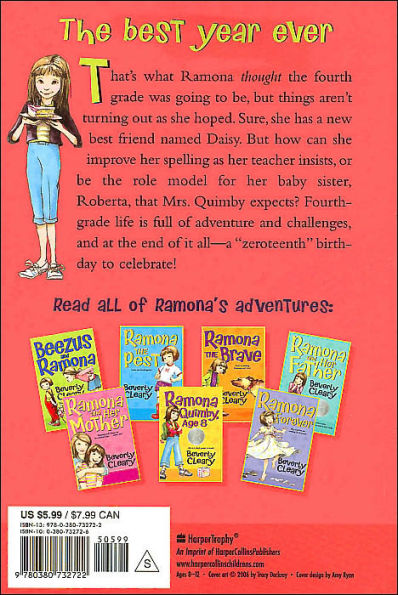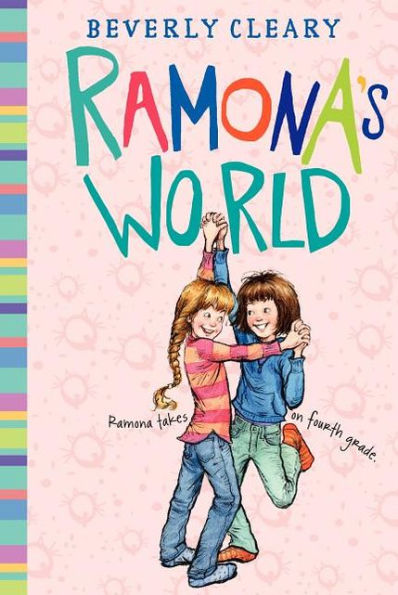Read an Excerpt
Chapter One Ramona Spreads the News
Ramona Quimby was nine years old. She had brown hair, brown eyes, and no cavities. She had a mother, a father, a big sister named Beatrice who was called Beezus by the family, and — this was the exciting part — a baby sister named Roberta after her father, Robert Quimby.
"Look, at her tiny fingernails," Ramona marveled as she looked at the sleeping Roberta, "and her little eyebrows. She is already a whole person, only little." Ramona couldn't wait for the first day of school so she could spread the news about her baby sister.
That day finally came. It was a warm September day, and Ramona, neat and clean, with lunch bag in hand, half skipped, half hopped, scrunching through dry leaves on the sidewalk. She was early, she knew, but Ramona was the sort of girl who was always early because something might happen that she didn't want to miss. The fourth grade was going to be the best year of her life, so far.
Ramona was first, to arrive at the bus stop in front of Mrs. Pitt's house. Mrs. Pitt came out the front door and began sweeping her front steps.
"Hi, Mrs. Pitt," Ramona called out. "Guess what! My baby sister is two months old."
"Good for her," said Mrs. Pitt, agreeable to a baby in the neighborhood. Babies did not scatter candy wrappers or old spelling papers on the lawn in front of her house.
Ramona pretended she was playing hopscotch until her friend Howie, who was already familiar with Roberta, joined her along with other children, some with their mothers, who were excited about the first day of school. "Hi, Ramona," he said, and leaned against a tree in thestrip of grass between the sidewalk and the street. He opened his lunch bag and began to eat his sandwich. Ramona knew he was doing this so he wouldn't be bothered carrying his lunch.
"Little boy!" Mrs. Pitt called out. "Little boy, don't you drop any papers or orange peels in front of my house. And stay off my grass!"
"Okay." Howie took another bite of his sandwich as he moved to the sidewalk. Howie was not easily excited, which Ramona sometimes found annoying. She was often excited. She liked to be excited.
When the yellow bus stopped, Ramona was first on board. She plunked herself down on a seat across the aisle from another fourth grader, a boy named Danny who was wearing a white T-shirt with Trail Blazers printed on it. Ramona called him Yard Ape because she thought he acted like an ape on the playground. She was glad he had not moved away during the summer. "I have a new baby sister," she informed him.
Yard Ape closed his eyes and hit his forehead with the palm of his hand. "Another Ramona," he said, and groaned.
Ramona refused to smile. "You have a little brother," she reminded him.
"I know," answered Yard Ape, "but we just keep him for a pet."
Ramona made a face at him so he wouldn't know she liked him.
When Ramona jumped off the bus at Cedarhurst School, she greeted old friends, most of them in new, or at least clean, clothes for starting the fourth grade. When she saw Janet, whom she had often seen in the park during the summer, the two girls compared calluses on the palms of their hands. "Your calluses are really big," said Janet, impressed.
It was true. Ramona's calluses were hard and yellow because she lived close to the park, where she often went with Beezus and her mother and Roberta on warm summer days. She worked hard at the rings — pump, pump, swing, pump, pump, swing--and by the end of summer she was able to travel down the line of rings and back again.
"There's Susan," cried Janet, and ran to join her. Reluctantly Ramona followed. "Hi, Susan," she said, eyeing Susan's short blond curls.
"Hi, Ramona," answered Susan. Neither girl smiled. The trouble was the grown-up Quimbys and Susan's parents, the Kushners, were friends. Ramona did not know what Mrs. Kushner said, but her own parents often said things like, "Now, you be nice to Susan," "Susan is such a well-behaved little girl," or "Susan's mother says Susan always sets the table without being asked." Such remarks did not endear Susan to Ramona. There was more. In kindergarten Susan did not like Ramona, who could not resist pulling the long curls she had at that time and saying, "Boing!" as she released them. In first grade, when the class was making owls out of paper bags, Susan copied Ramona's owl. The teacher held up Susan's owl to show the class what a splendid owl Susan had made. This seemed so unfair to Ramona that she crunched
Susan's owl and found herself in trouble, big trouble. So how could anyone expect the two girls to befriends? As Ramona expected, the calluses on Susan's hands were so small they could scarcely be seen.
ThenRamona saw a new girl who was standing alone. A new fourth grader, Ramona decided, and because she admired the girl's long fair hair she wentover to her and asked, "What's your name?"
"Daisy," answered the girl. "Daisy Kidd." When she smiled, Ramona saw that she was wearing bands on her teeth. "What's your name?"Daisy asked. As Ramona told her, the bell rang, ending their conversation.
On her way to the fourth grade Ramona passed her former classroom, where the teacher was standing outside the door welcoming her new class. When she saw Ramona, she waved and said, "How's bright-eyed, bushy-tailed Ramona?"








